Case Study: Big Agnes
Research, analysis, strategy and site redesign for e-commerce effectiveness
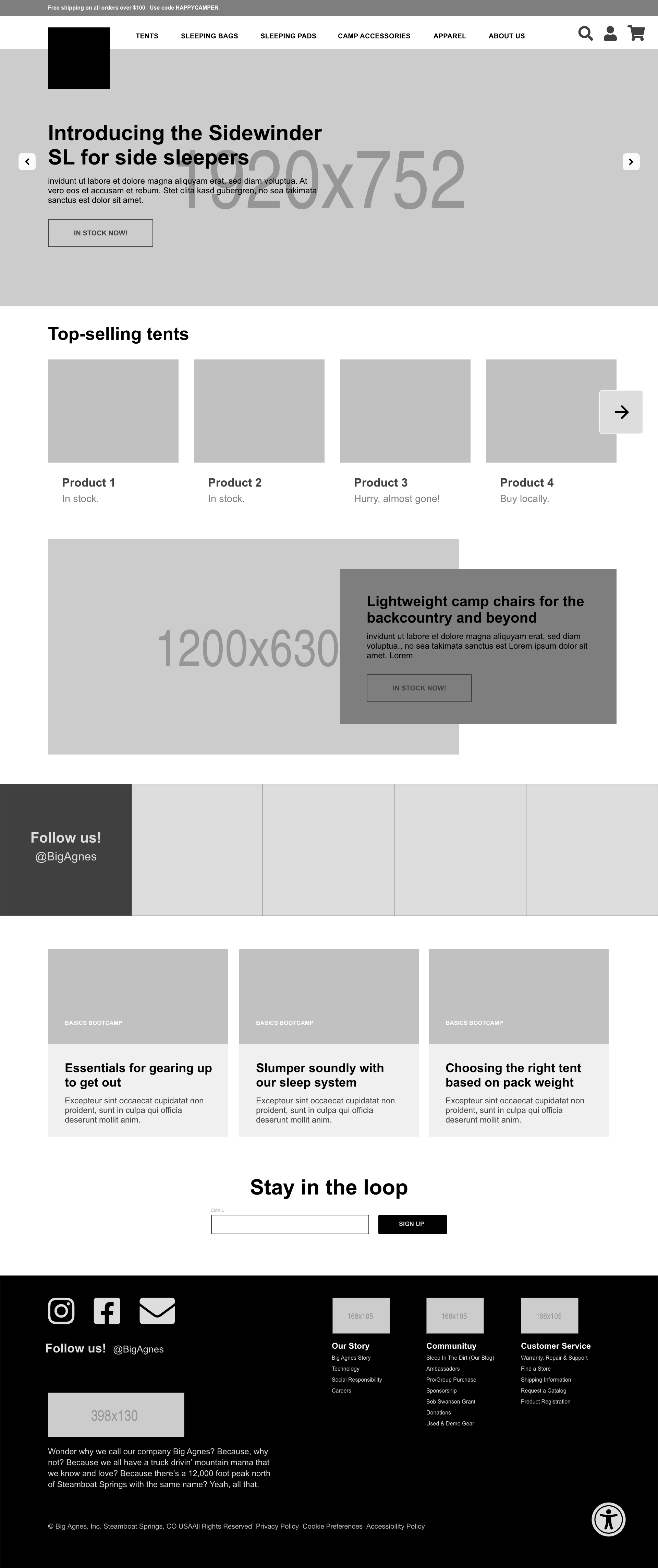

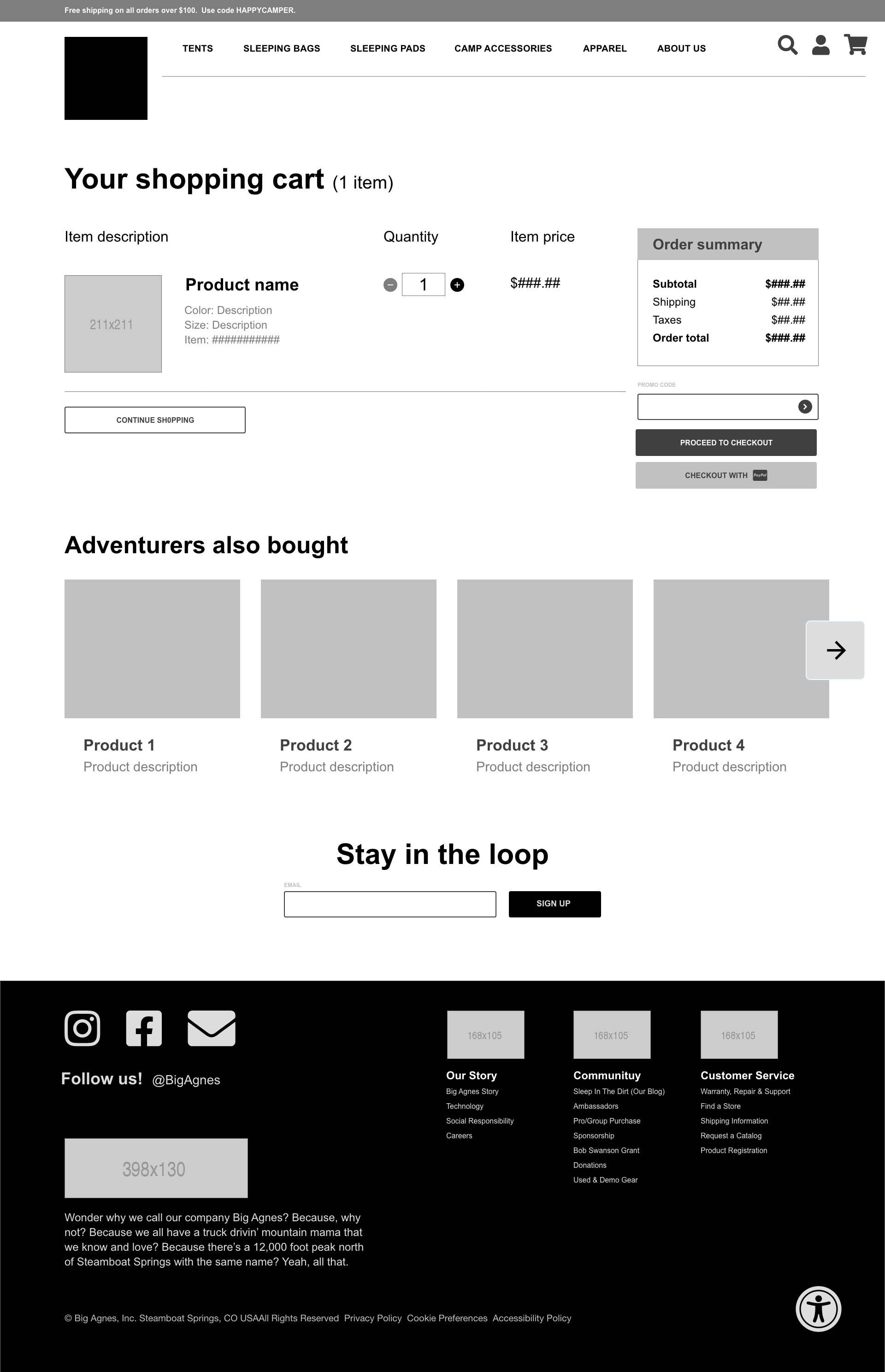
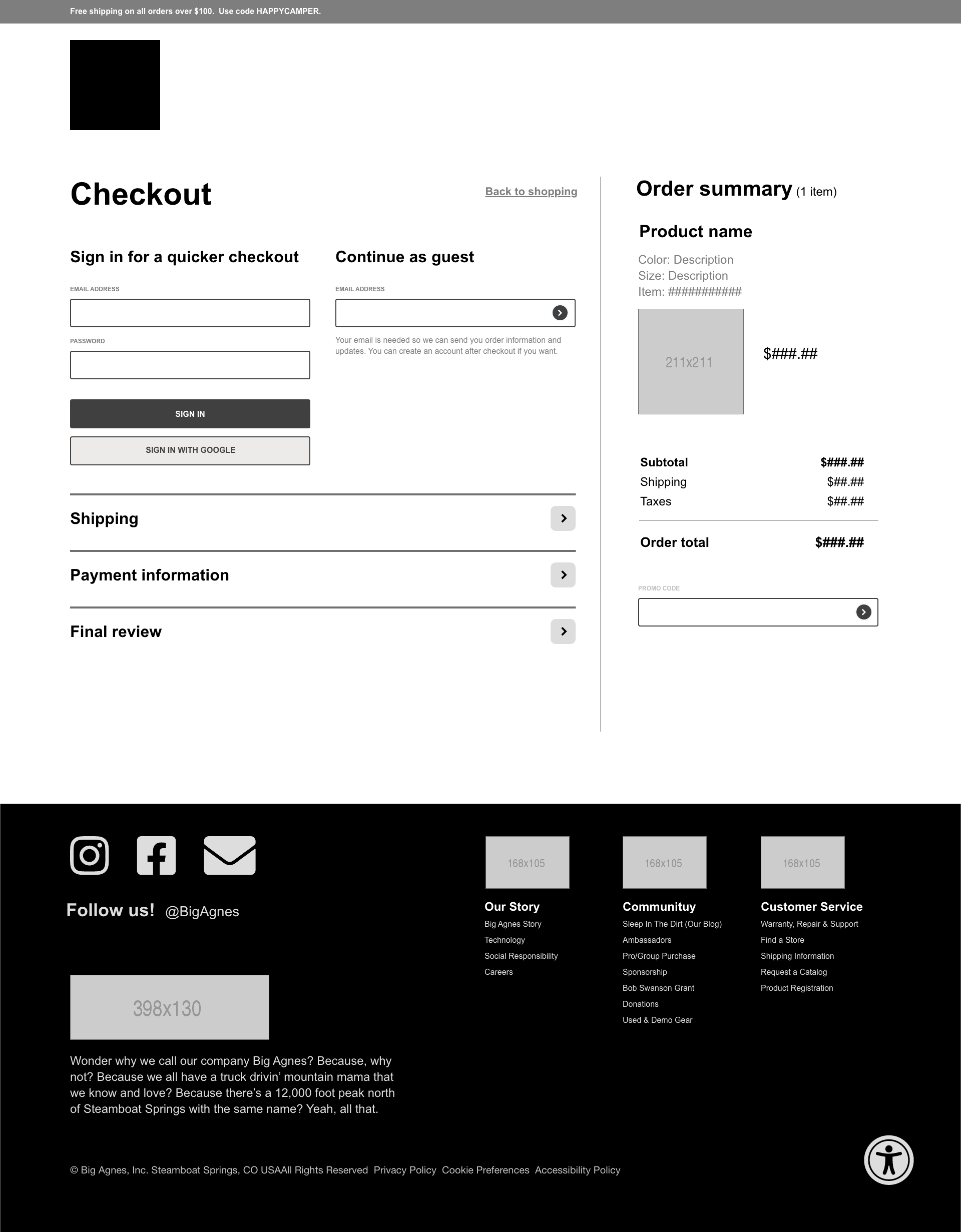
This e-commerce project was part of my graduate studies in user experience design. I researched an existing brand using publicly available data, synthesized data and created design artifacts to inform the redesign process. This culminated in the creation of wireframes to address user pain points. The resulting wireframes solved for issues with product pages, search as well as the add-to-cart and checkout process.
Highlights
Competitive and SWOT analysis
Target audience research
Persona
Customer journey mapping
Usability analysis
Web metrics and analytics
SEO strategy
Wireframing
Tools: Adobe XD, Google Suite
Overview: The Problem
- Fricton in the online ordering user experience.
- Unclear product distinctions and heavy use of internal jargon.
- Confusing navigation.
- Niche target audience.


Overview: The Solution
- Five KPI's were identified and a strategy created for each to optimize the site for conversions, improve user experience, provide insights into the most effective marketing strategy and to focus on growing and retaining the target audience
- A persona was created of the target audience.
- A user journey was created to highlight pain points and opportunities in the gear purchase process.
- New website wireframes were created to address usability issues and to align with the new performance strategy of the site.
A detailed report on the approach to these artifacts and strategies is below.
Research
The research phase included a competitor and SWOT analysis, a usability analysis and audience research. All of the data was gathered from publicly available sources which required some creative research methodologies including online resources such as SimilarWeb, Google Search Console and reports on the outdoor recreation industry.
Competitor and SWOT Analysis
Big Agnes is a small outdoor gear company that sells high-performing tents, sleeping bags and sleeping pads. This is specialized gear more suited for backpackers and adventurers over the average car camper. This specialization is reflected in the price point and technology behind the products. Big Agnes gear is designed to be both durable and lightweight. The target audience is willing to pay more to get warmer and more specialized products for the lightest weight possible. As an avid hiker and backpacker, I can confirm that these factors go into the purchasing decisions — it’s often better to spend more than to be miserable on a long hike with gear that is too heavy or ineffective against the elements.
Though the Big Agnes site is generally easy to use, a competitor analysis grid (link to spreadsheet) required me to thoroughly consider the differences between Big Agnes and these competitors. The differences in user experience were most obvious in the online ordering process and the customer service links.
A SWOT analysis (link to spreadsheet) helped to identify how Big Agnes stands out among competitors and what the company can do to grow their market. Analyzing competitors and completing the SWOT analysis was helpful in getting a clearer view of Big Agnes’s place in the outdoor gear market.
A keyword search revealed 46 companies that may be competitors. The list was resorted to identify the companies that appeared most frequently and then analyzed to find the two most direct competitors in the market. NEMO Equipment and Marmot were selected for the similarity of the key product lines Big Agnes features.
Big Agnes Usablity Analysis
A usability analysis helped identify issues with the site in several categories including ease of use, ease of understanding, ease of naviation and aesthetics.

Easy to use
Product pages were identified as areas for improvement. Each product includes a price range and sizing options, however, by default these options are greyed out which makes it appear as though the product is unavailable. That may or may not be the case. The user is required to input selections before seeing if a product is available.
Unlike its competitors, Big Agnes does not automatically show out-of-stock status on the product sections or pre-load nearby retailers in the case of a product being out of stock. Currently, the site requires many steps for the user to continue to purchase.
Easy to understand
Big Agnes uses internal langauge for the classifications of its products which can be confusing to the average user.
One example is the tents section of the site. Tents are organized into categories which are difficult to compare, including “Crazylight,” “Ultralight,” and “Superlight.” As an average user, I could not discern which is the lightest of the set. Additionally, the site did not provide clarity on the differences between the options.
Aesthetically pleasing
Overall the site is visually pleasing with large, colorful photographs. The product photos are bright and easy to compare. Most products include multiple views. Typography follows a clear hierarchy on the site. All text is clear and easy to read.
Product specifications are easy to find and well organized. The footer is well organized with easy to understand links. The site is well designed on both desktop and mobile.
A floating accessibility menu on the homepage gives users control over the display of the site.
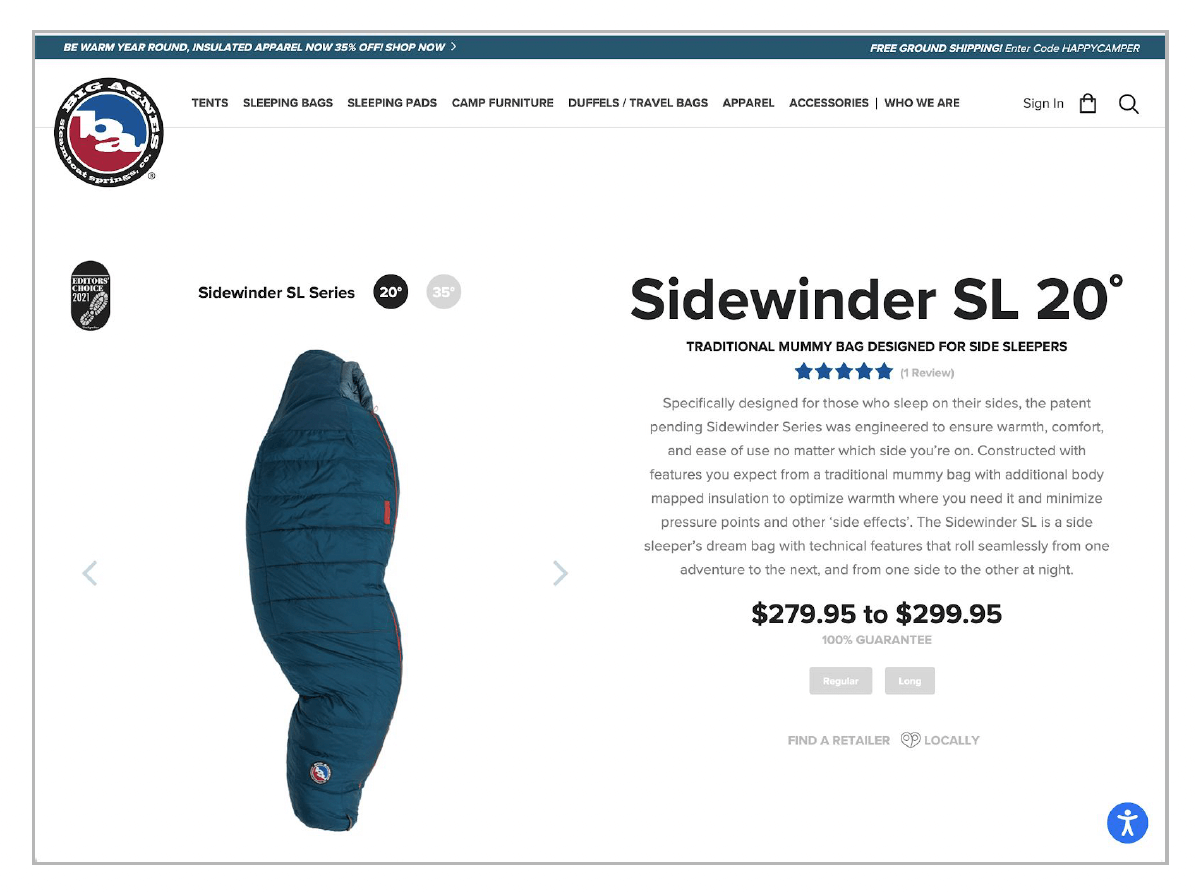
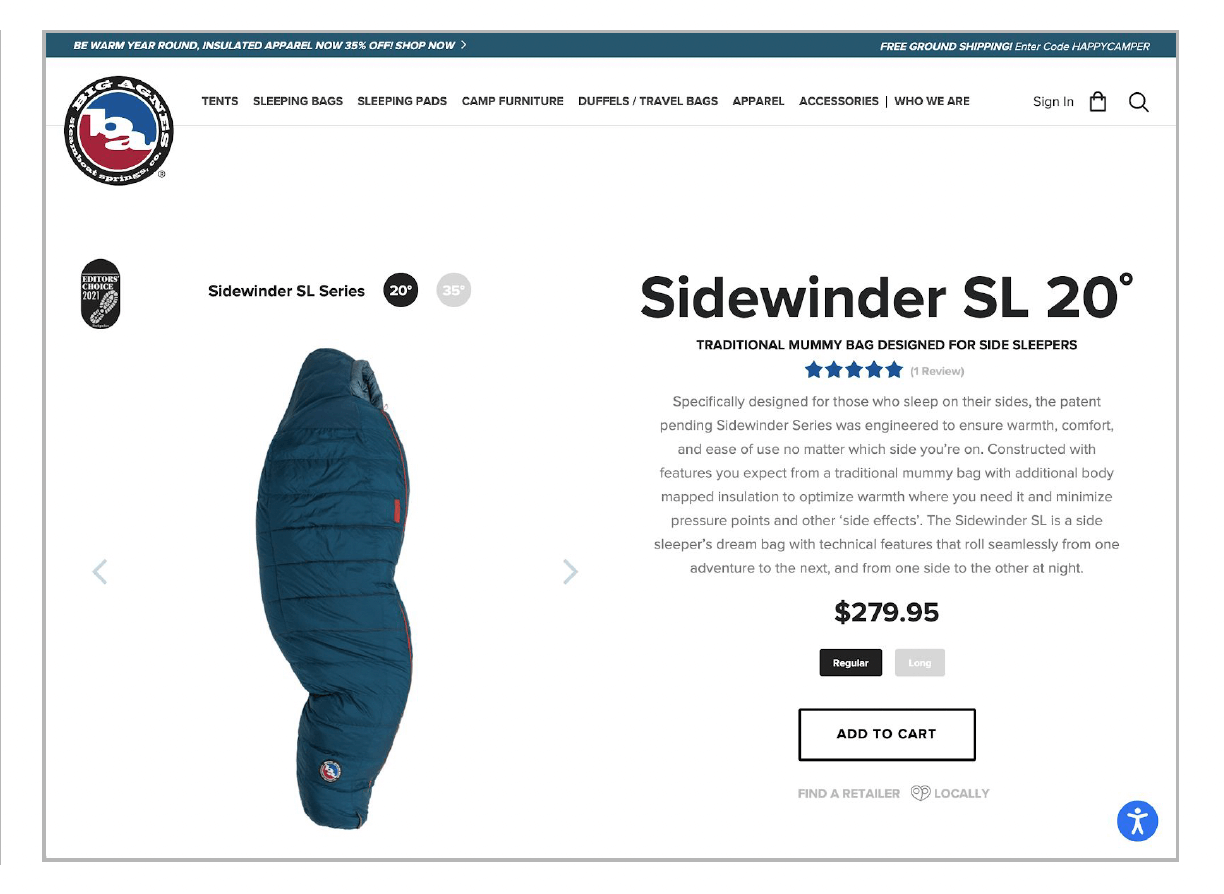

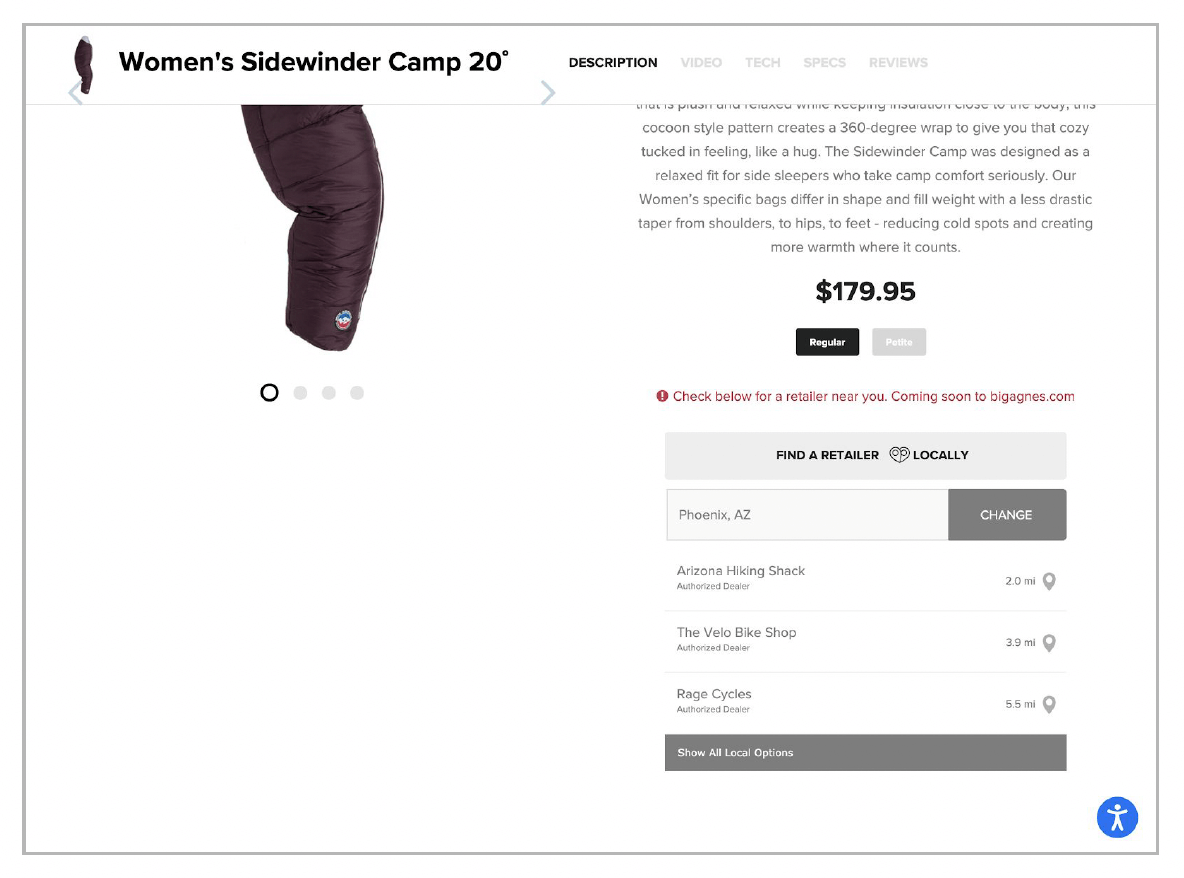
Easy to navigate
The main navigation tabs are not clickable — a user must select an item from the dropdown menu. This was frustrating as a user since I often made the mistake of trying to click on the tabs to get to the general product page for the category. The tabs should link to the overall product page — for example, the sleeping bags tab should link to “See All Bags” for a more seamless user experience.
Users unfamiliar with the categories would benefit from an overview page of all the products in a section. This was especially true in the tents section where the categories were hard to discern.
Once users are in the “See all” page of each section there is product filtering on the left side of the page that allows users to find the exact type of product they are searching for. When filtering by weight, however, the weight categories from each section are not highlighted in the results, so it is hard to see which tent fits within which category. These categories are visible, however, if you navigate to the product page by selecting one of the categories such as “Superlight.” These category pages include an overview of the product category and a list of filterable products at the bottom of the page.
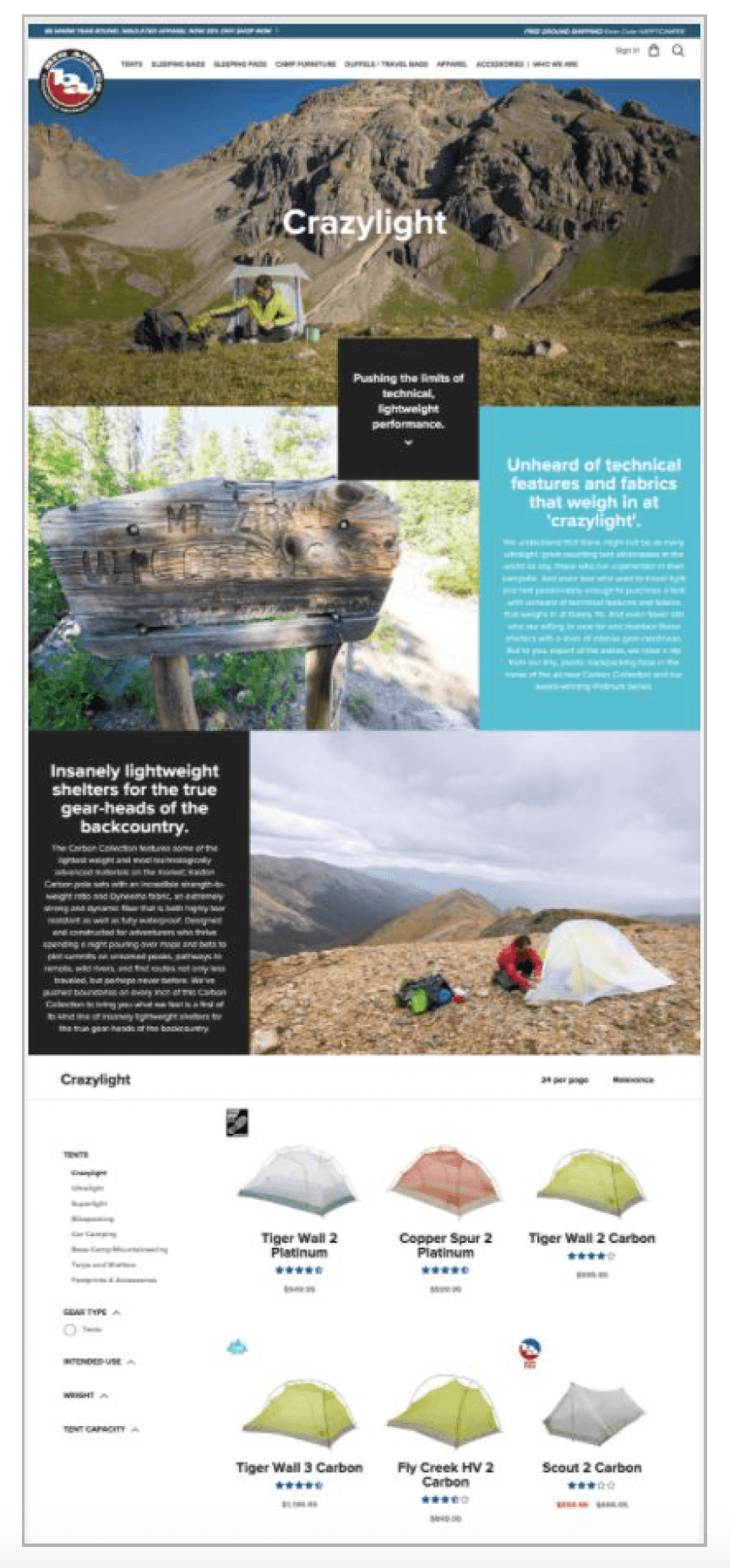
Usability Analysis Conclusion
While Big Agnes does some things well or on-par with competitors, there is a lot of room for improvement. The main navigation should be clickable to make it easier to use. The product section categories should be updated to be easier to understand, especially in the tents section. Additionally, the ordering process needs to be updated to give the user more information in less clicks. Big Agnes does beat out its competitors in the accessibility of the site, with customizable features that are easy to adjust on desktop and mobile. Improvements to usability on the site will make Big Agnes even more competitive in this niche market.
Target Audience
Big Agnes creates specialized gear that is suited for experienced bikepackers, backpackers and adventurers rather than the average family on a campground getaway. Though there are no publicly accessible user demographics for Big Agnes site visitors or followers, much can be extrapolated from both the types of products being sold as well as the stories and posts the company puts out on social media and their blog. Additionally, as an experienced backpacker myself, I have an understanding of the types of individuals shopping at the retailer as well as some of the motivations behind purchase decisions.
Building an Understanding of the Target Audience
Publicly accessible information reveals insights into the Big Agnes target audience. SimilarWeb ranks Big Agnes as 473 in the category rank for e-commerce and shopping worldwide (2021). Site engagement is 198.28K total visits with an average duration of 00:02:32 and 3.86 pages visited. The bounce rate is 51.74%.
The largest portion of site visitors come from the U.S. at 66.97%, followed by Canada with 7.67% of visitors. Though the visitors can be from any location in the U.S., for the purpose of creating a target user persona, a location popular with outdoor activity would make sense as such locations would likely have many Big Agnes customers. According to Trip Advisor, one of the best cities for hiking includes Denver, “the gateway to the outdoor playground of the Front Range.” Given the many opportunities for outdoor recreation, and the likelihood of someone interested in outdoor recreation living in a state known for it, it will be the location for the target audience. Further, Colorado is also home to Big Agnes headquarters so there may be a higher affinity for the brand in the state.
198.28K
total site visits
51.74%
bounce rate
66.97%
U.S. audience
According to SimilarWeb, most visitors find the site through search (61.53%) or navigate to the site directly (32.23%) signifying these visitors are likely familiar with the niche brand. All of the search traffic is organic, with the following top-performing search terms: “big agnes,” “big agnes tents,” “big agnes copper spur hv ul2,” “bigagnes,” and “big agnes tent.”
The majority of social traffic, which only makes up 2.53% of all traffic, comes from Facebook (46.22%) followed by Reddit (29.99%) and YouTube (23.69%). Both Reddit and YouTube are sources for gear reviews and discussions about backpacking, bikepacking and camping. Likely, most buyers do some level of research to compare different products and companies to make sure they get the best gear for the price they are paying for such specialized products.
Price Point
Big Agnes gear is designed to be both durable and lightweight and these innovations do not come cheap. The average cost of a sleeping bag on the site is $250 — a large jump from the $30-$40 sleeping bag the average consumer can get at their local Target store (Target, 2021). Sleeping bag temperature ratings also range from -40 degrees fahrenheit — much colder than most casual campers attempt for an excursion. Big Agnes’ target audience is willing to pay more for quality products that fit their adventure needs.
Product Construction and Quality
As stated above, Big Agnes gear is specialized. Tents are categorized as “Crazylight,” “Ultralight” and “Superlight.” Though these categories may be confusing to the layperson, ultra-light backpackers — the kind that cut off the tags on their clothes to cut weight — feel right at home. These adventure-seekers understand they can hike farther and explore longer when they don’t have a bulging pack of heavy gear weighing them down.
Product page content also helps to identify the target audience. Users looking at “Superlight” tents, might say, “I backpack, camp, and just love getting out” and according to Big Agnes, “If that sounds like you, keep reading. Our versatile Superlight tents might be the perfect fit” (Big Agnes, 2021). “Ultralight” tent users are identified as those who bring “all you need, nothing more,” much like the ultralight tents. Appealing to the “Crazylight” group, the product copy reads:
We understand that there might not be as many ultralight, gram-counting tent aficionados in the world as say, those who run a generator in their campsite. And even less who want to travel light and fast passionately enough to purchase a tent with unheard of technical features and fabrics that weighs in at barely 1lb. And even fewer still who are willing to care for and maintain these shelters with a level of intense gear-nerdiness. But to you, expert of the extras, we raise a nip from our tiny, plastic backpacking flask in the name of the all-new Carbon Collection and our award-winning Platinum Series. (Big Agnes, 2021)
Through these descriptors appealing to the target audience, the traits of these audiences can start to be reverse-engineered.
Sustainability
Big Agnes’ latest tent innovations include “solution-dyed fabrics which drastically reduce water and energy consumption during manufacturing” (Big Agnes, 2021). The site highlights the company’s approach to social responsibility and the many partnerships they have in this cause. The company also supports sustainability through its repair program to fix much-loved items in need of repair “as inexpensively as possible to encourage keeping gear alive rather than sending it to a landfill.” The company does this because it is the right thing to do but also because the target audience is likely concerned with sustainability and the environment. By backing sustainability ideals, the company positions itself as a place enivronmentally-concerned consumers would want to spend their money.
Broader Audience Understanding: Who Recreates Outdoors in the U.S.?
Though there is no demographic data freely available on Big Agnes customers, there are some sources that can help to define the demographics of those interested in their gear. Big Agnes supports the Outdoor Industry Association, a group that “collaborates with members and key stakeholder groups” to make an impact in “outdoor recreation and trade policy, sustainable business innovation and outdoor participation” (OIA, 2021). This group, through their Foundation, collects data annually to create an “Outdoor Participation Report.” The 2020 report is the result of over 18,000 online interviews from a nationwide sample in which quotas were met to ensure a balanced sample in relation to “gender, age, income, region and ethnicity” (Outdoor Foundation, 2020). Participants were:
- 54% male, 46% female
- 71.5% caucasion/white, non-hispanic
- A majority (57%) of households had children
- 61.6% reported at least some college-level education
- Participants had a median age of 37
- Household incomes were slightly higher than average, with 46.8% earning household incomes of $75,000 or more (compared to 46.4% of the overall U.S. population in 2019).
- The interest level for camping was the highest for adults aged 18-24 and 25-34, and second highest for adults aged 35-44.
- The interest level for bicycling was highest for adults aged 45-54 and 55-64.
- Hiking was rated as fifth out of five for interest in adults aged 34-44, 45-54 and 55-64.
- There is a diversity gap in outdoor participation with only 9.4% of African American/Black respondents participating (compared to making up 12.4% of the population) and 11.6% of Hispanic participants (compared to them making up 17.9% of the population).
- When it comes to race and ethnicity, hiking is the most popular outdoor activity for caucasian participants with camping coming in at fourth on the list. Camping also fell in 4th place for African American/Black and Asian participants. Camping was slightly more popular among Hispanics in third place on a scale of 1-5.
Target Audience Conclusion
Given the information gleaned from the Big Agnes website as well as the snapshot on outdoor participation by the Outdoor Foundation, a picture starts to emerge on the target audience. They are largely male and caucasian from the ages of 18-44. They earn an above average income compared to the U.S. population and they have completed some college. They are also likely to have children.
The target audience has very niche interests compared to the rest of the population. They also have discriminating taste — they’re willing to pay much more for certain features in their gear. The audience is either upgrading cheaper gear they previously bought for products that work better or they are willing to spend more upfront to get the right item from the start. Though already interested in a niche outdoor activity, some of the target audience can be categorized in the ultralight group, a subset of the average backpacker. The audience is also passionate about the outdoors and protecting the environment to ensure access to current and future generations.
Strategy
Target Audience Persona
Synthesizing the data led to the creation of a target audience persona. A user journey map was created to focus attention on this user and their pain points along the purchase processs. KPI's were identified with proposed strategies for each to increase performance.
The persona was created using publicly available information about Big Agnes’ site visitors through SimilarWeb, as well as an analysis of the website body copy, which was clearly geared toward a particular type of user. Broader audience demographics were gleaned from a report by the Outdoor Industry Association, an organization that Big Agnes supports. The persona can also be viewed here (PDF).
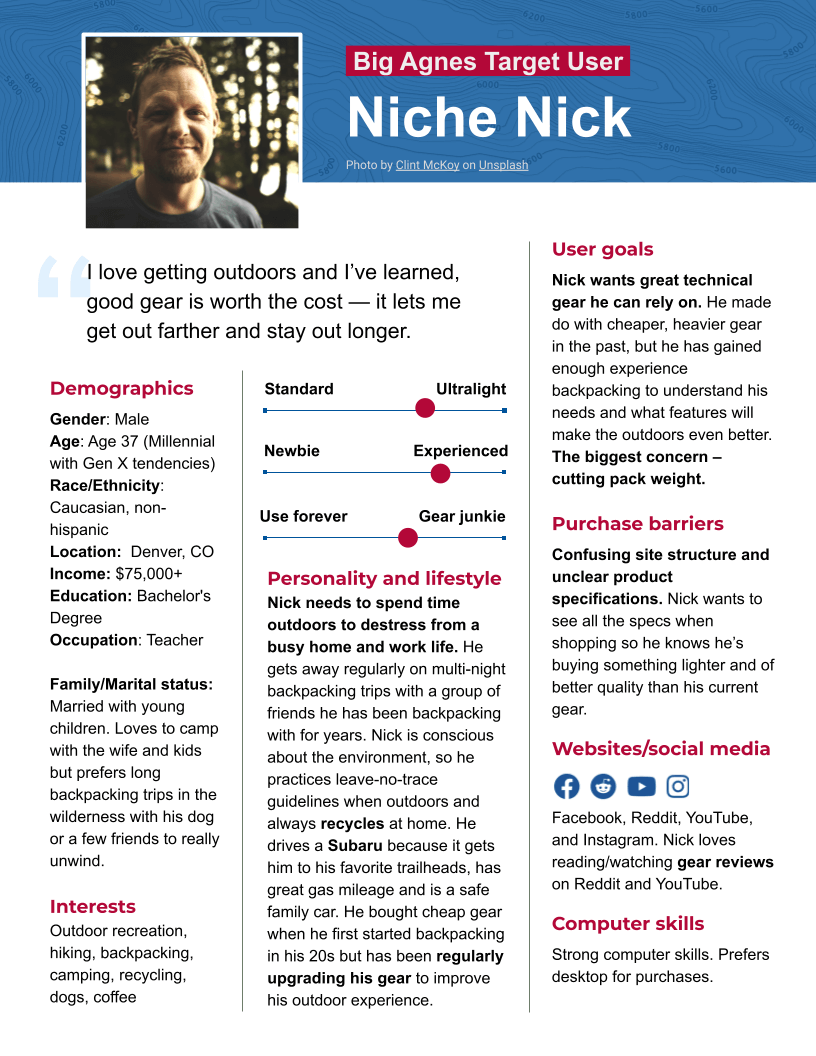
User Journey Map
A version of this user journey map can also be viewed here (PDF).
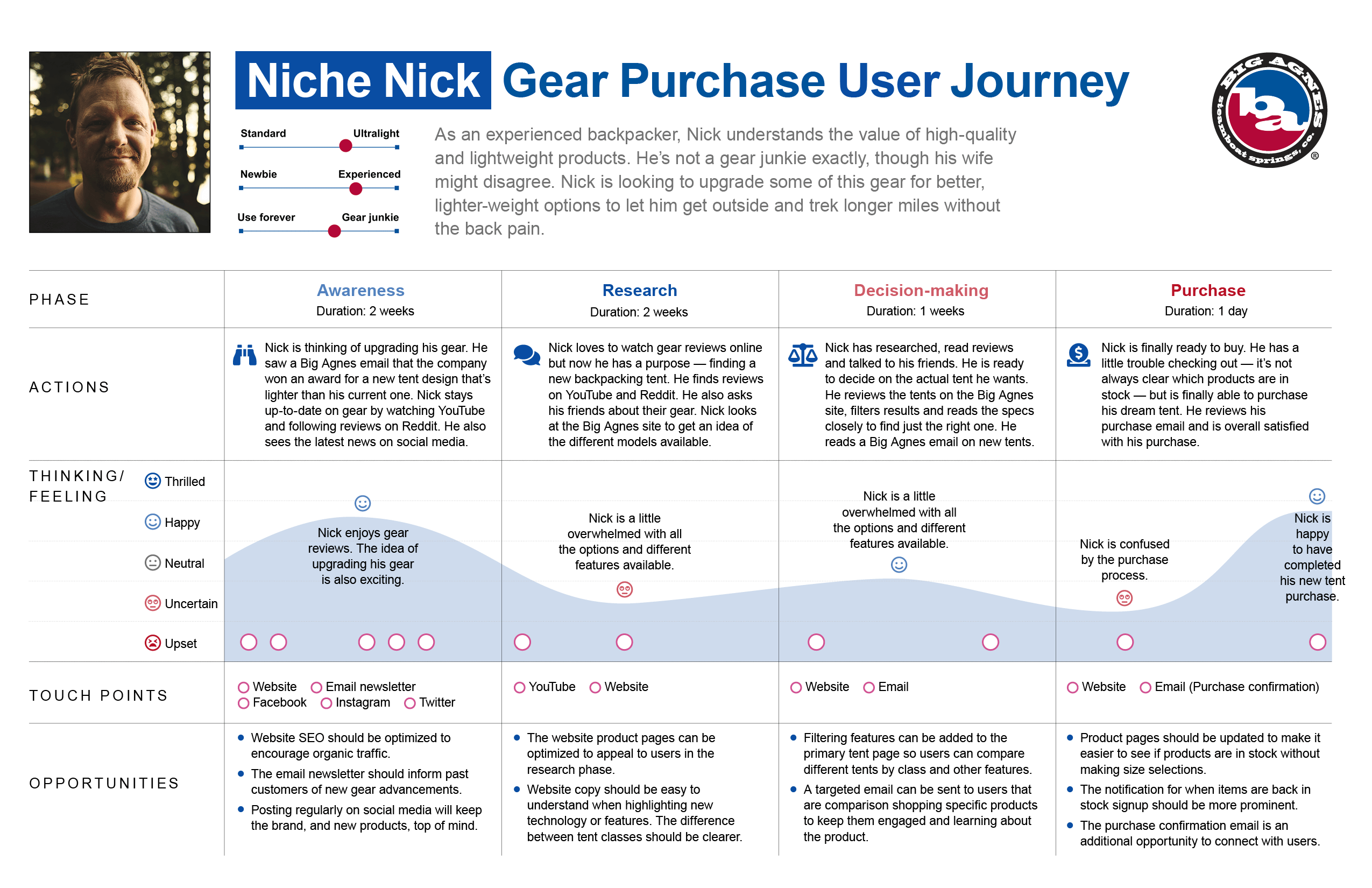
Target Analytics and Metrics — Strategy
Big Agnes’ growth is reliant on finding it's niche audience and tailoring messaging to them whether they need new gear to start or they are looking to upgrade much-loved products. Additionally, all website and customer data needs to be reviewed to ensure customers are not being left behind due to website design or processes.
There are five KPI’s Big Agnes should focus on to improve the user experience of the site as well as to increase traffic. These include the conversion rate, email subscribers, exit pages, branded searches, and the customer retention rate.
1. Conversion rate
In order to grow Big Agnes, the primary focus of the conversion rate will be on the successful completion of a purchase. According to data from SimilarWeb, Big Agnes site engagement includes 198.28K total visits with an average duration of 00:02:32 and 3.86 pages visited (2021). The bounce rate is 51.74%. Understanding the conversion rate will help to see what portion of these visitors ultimately make a purchase and if any adjustments need to be made to the product pages or checkout process.
Ultimately, the conversion rate will be impacted by adjustments made to the site based on the information gleaned from tracking other KPI’s described below. Incremental, data-based adjustments will help to increase performance. However, it is important to first understand the current situation on the site before making changes. From there, the goal will be to increase the conversion rate. This indicator will be the ultimate sign of successful modifications to the site.
Another conversion rate to track includes email newsletter signups. Because Big Agnes serves a niche audience, it's important to take advantage of site visitors and encourage them into the sales funnel. Growing the email newsletter audience and serving that audience with useful content and exclusive offers can impact purchases, and the bottom line, if done well.
2. Email subscribers
Tracking email subscribers is important because email has a median return on investment (ROI) of 122 percent, which is four times higher than that of social media, direct mail and paid search (Crowe, 2019). Increasing email subscribers can greatly increase the conversion rate. Additionally, because Big Agnes customers are a niche group, it is important to take advantage of every site visitor to encourage them to sign up for the email newsletter. Email can help nurture the audience toward making a purchase.
Improving the conversion rate of email subscribers would include A/B testing different wording in the newsletter sign up call-to-action (CTA) and button. Currently the email signup is located in the footer of the site with the text, “Stay in the Loop” and a button directing users to “Sign Up” (Big Agnes, 2021). Different variations on CTA text and button can be tested to see if it increases conversions. Additionally, color can be tested on both the CTA and the button to draw more attention to the form.
Another element that can be A/B tested in regard to the email form is the placement of this element on the page. Would shifting the form farther up on the page increase conversions? There are all things that can be tested to improve performance.
3. Exit pages
Exit pages are “the pages the customer exits your site” (Hilary, 2021). These pages can indicate problems on the site — whether these pages are confusing to customers or just not well optimized. Examining exit pages will also help identify which pages are the best candidates for A/B testing to incrementally improve the user experience.
Exit pages should be reviewed closely to identify problem areas. All content and links should be reviewed to determine if unclear copy or broken links are causing the exits. If a high exit rate is found during the checkout process (before the final purchase step), it would be helpful to identify which parts of the process are slowing down users. Issues during the checkout process may be related to shipping costs, payment options or a lack of trust in the site to complete purchase. Understanding where and why users exit will help to identify possible solutions.
One tool that may help to better understand the issues of high exit pages is a heat map. Heat maps show where and how users navigate pages, including where they click, pause and get confused (Hoos, 2018). Another tool to understand user motivations is to conduct user testing. User testing gives qualitative data to the team — the user talks through their thought process when navigating the site to complete certain actions. This can help further identify areas of improvement to positively impact the conversion rate.
4. Branded searches
Branded searches are “keywords that include your brand name or a variation of your brand name” in search and are known for their high conversion rate (Crowe, 2019). This would include search terms such as “big agnes,” “big agnes tents,” “big agnes copper spur hv ul2,” “bigagnes,” and “big agnes tent” — all of which were the top performing organic search terms for the site (SimilarWeb, 2021).
Branded searches can be measured through Google Search Console. This metric shows what users familiar with Big Agnes are searching for. It can identify hot products or areas to direct marketing efforts.
For instance, Big Agnes tents seem to be areas of high interest in search. Running a paid advertising or retargeting campaign using these keywords may lead to a higher number of site visitors and conversions.
5. Customer retention rate
Finally, understanding the customer retention rate is important in maintaining and building a large audience. This is especially important when working with a niche audience. It costs companies “5-25x more to gain a new customer than it does to sell to an existing one” (Crowe, 2019).
Big Agnes tries to capitalize on this by offering a sleep system — sleeping bag, sleeping pad and pillow — that interlocks to prevent slipping out or sliding overnight. Offering multiple products that work well together encourages users to buy more than just one piece of the system. Users that are happy with their purchase of one product should be nurtured to return to the site to optimize the rest of their system. Customers that are happy with their products and their purchase experience are more likely to be repeat customers.
The best way to measure the customer retention rate is by tracking the customer churn rate (Crowe, 2019). A high churn rate would indicate issues with the products or the site. Customer retention can be increased through special marketing campaigns directed at customers after they have made a purchase. This could include a special email offer on a different item from the sleep system to entice them to stick to Big Agnes for their gear setup. This could also include retargeting ads to keep Big Agnes on their radar. These types of campaigns would be beneficial for both the types of customers that are just starting to build out their gear setup as well as those that are looking to upgrade their existing gear.
Target Analytics and Metrics Strategy Conclusion

By focusing the strategy on conversion rate, email subscribers, exit pages, branded searches and the customer retention rate, Big Agnes can greatly improve its overall performance. This strategy will optimize the site for conversions, improve user experience, provide insights into the most effective marketing strategy and will focus on growing and retaining the target audience. Though much of the data can be found through free tools, some software purchases will be required to provide more detailed information to ensure the most accurate data is in use to support any changes to the website. Using this data to inform A/B testing decisions will result in low-risk, data-based improvements to the site and will positively impact the business.
Redesign
All of the research and strategy planning led to the creation of new wireframes for the Big Agnes homepage, shopping cart and checkout process for both mobile and desktop experiences. The wireframes were created in Adobe XD. Some interactivity was included to demonstrate functionality as well as the user flow in the checkout process.
Interactive wireframes can be viewed at this link.
Homepage
The existing Big Agnes homepage included many large, full frame photographs that dominated the page. The revised wireframes simplified the homepage by reducing the number of large images. The content changes also focused on utility for the target audience.


Top-selling products were added to just below the header. This brings popular products to the attention of users. Additionally, the status of items is included in this slider — whether an item is in stock or almost gone. Items that are out-of-stock are displayed with the text, “Buy locally,” so that users can see, at-a-glance, what is available for purchase on the site and what is sourced elsewhere. This feature will reduce user frustration and reduce the amount of steps users must take to find out if an item is available online through the retailer.
Following the top-selling products section is a callout for a featured product with a short blurb that will take the user to the product page. This is followed by a social media feed which has been slightly reduced in scale. Social media posts capture the inspirational experience of using the products in the outdoors. The section includes a prompt encouraging users to follow Big Agnes on social media.
The following section includes new articles, or a “Basics Bootcamp,” that inform users of different aspects of the gear as well as tutorials on how to get started in backpacking. The existing Big Agnes site used a lot of jargon and had confusing categories for their products, especially in the tent classifications. A single overview article that explains the classifications of each type and its benefit aids users in selecting the right product for them. Additionally, these articles will aid in the SEO of the site, driving more organic traffic to the homepage.
The mobile version of the homepage is the same as the desktop version with the difference of the menu shifting to a hamburger menu in the top right corner.
The footer was kept from the existing site with the exception of the email sign-up being pulled out to give it more emphasis. Social media integration was added to the sign-in on the site, both from the main navigation and in the checkout process. This change makes the sign-in process easier for users.
Shopping Cart
The existing shopping cart had limited information. The new wireframe updated the layout to be more organized. Additionally, a new section was added to highlight complimentary products. Labeled “Adventurers also bought” — this section will feature add-ons for the items in the cart. For instance, if a customer is purchasing a sleeping bag, a sleeping pad and a lightweight inflatable pillow would be included in the suggested products. Similarly, if a tent was in the cart, items might include a footprint to protect the tent floor, or sleep system products. Products listed here would range from low-cost add-ons to bigger ticket complimentary products. The new shopping cart will also include an opportunity for email signup.

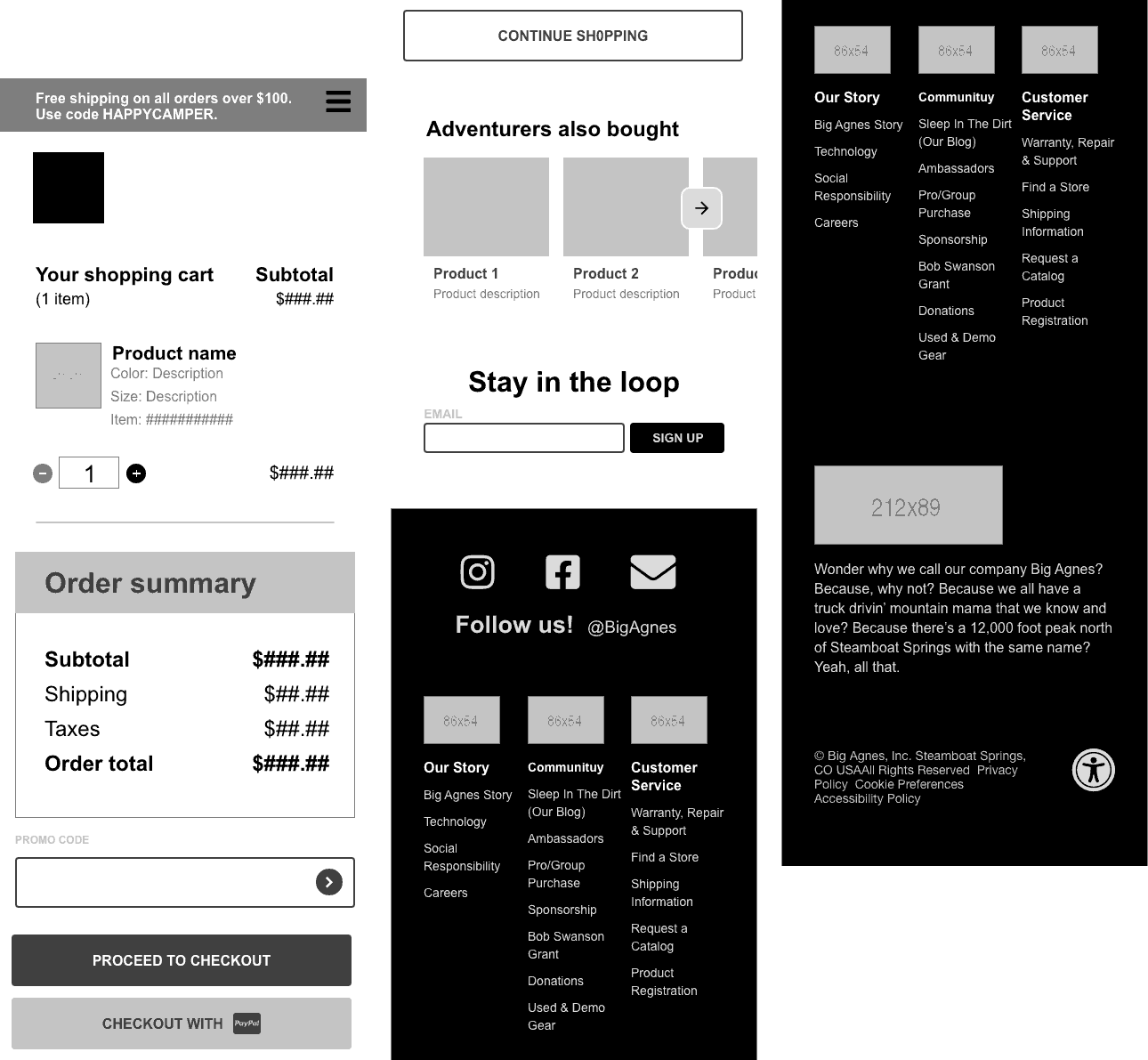
Checkout Process
The existing checkout process included two screens after the shopping cart step — a sign in page followed by a long form for purchase completion. In the new wireframes, the checkout process was simplified into one page with drop-down sections that move the user through the process. This change was to break down the checkout to smaller steps, visually show the user where they are in the process at any given step, and to provide a cleaner, simplified layout. To keep the user focused on checking out, the main navigation has been removed.
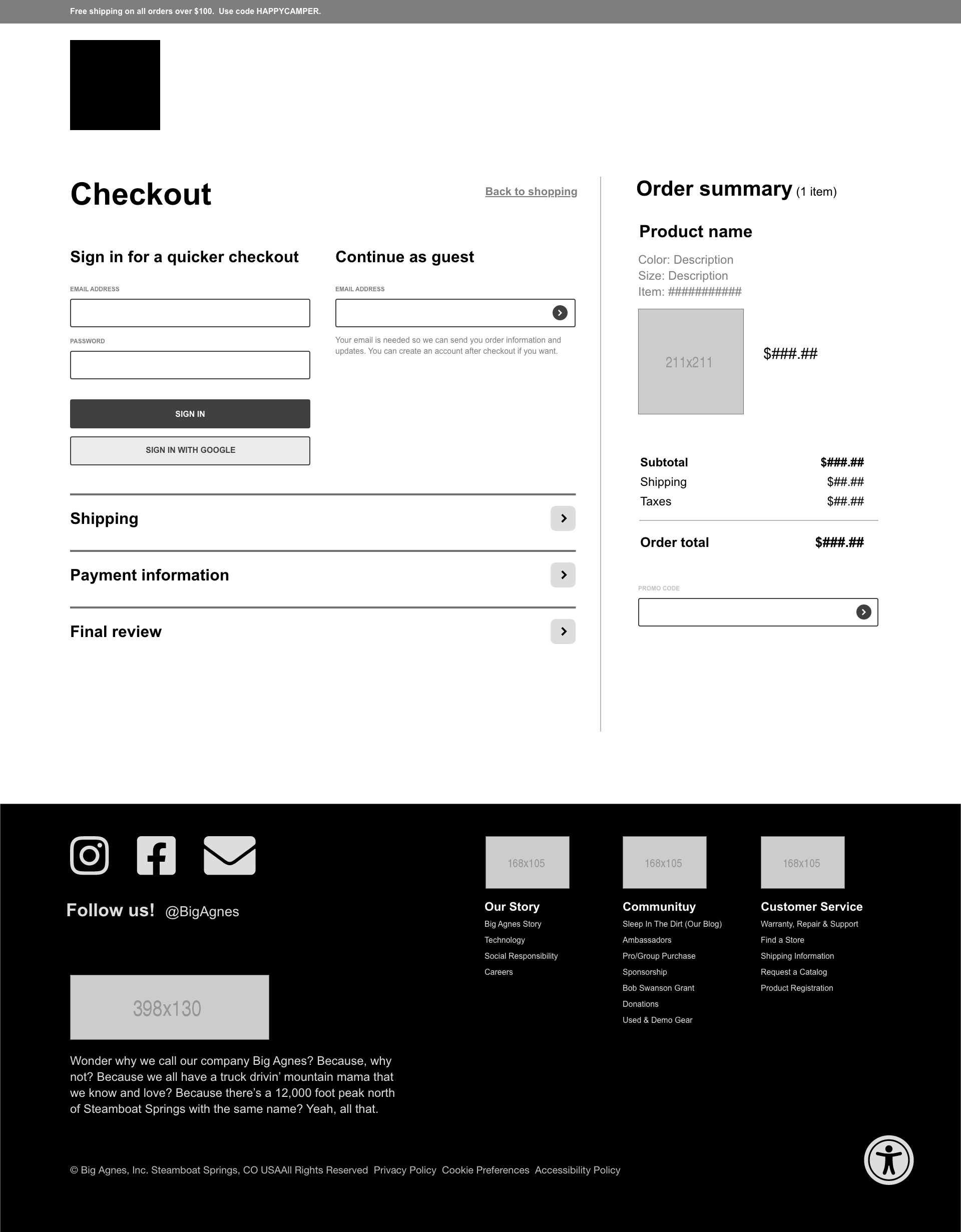
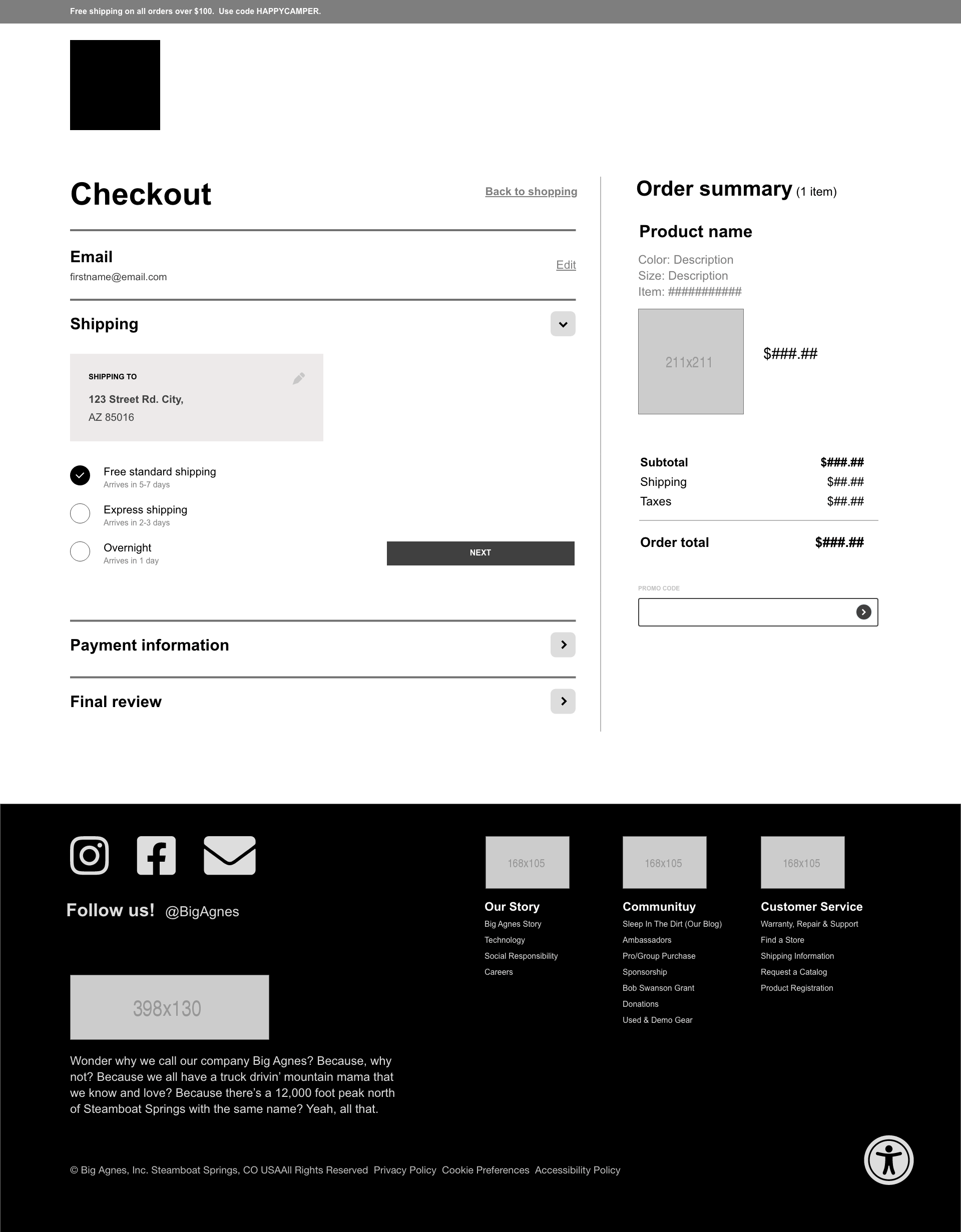

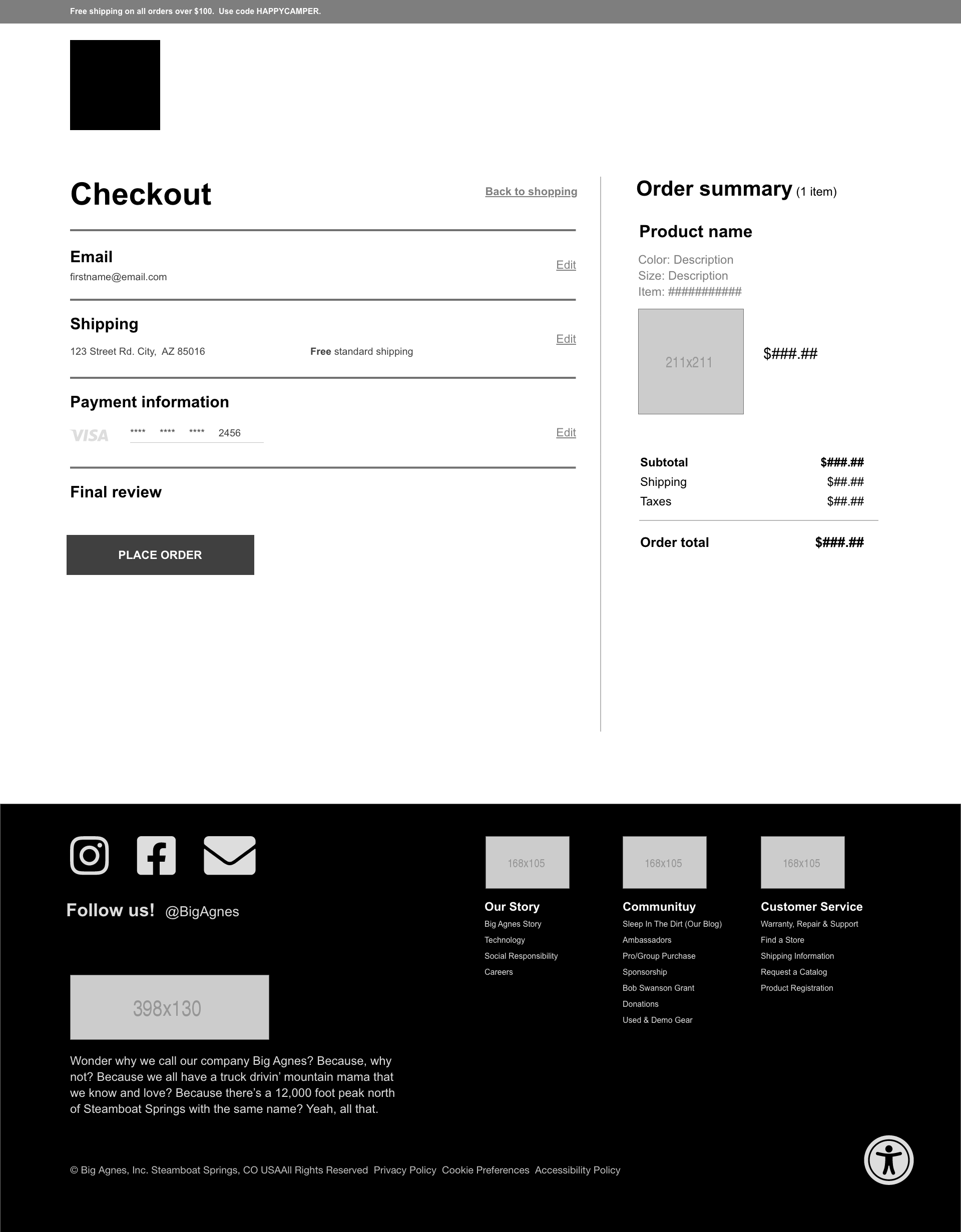
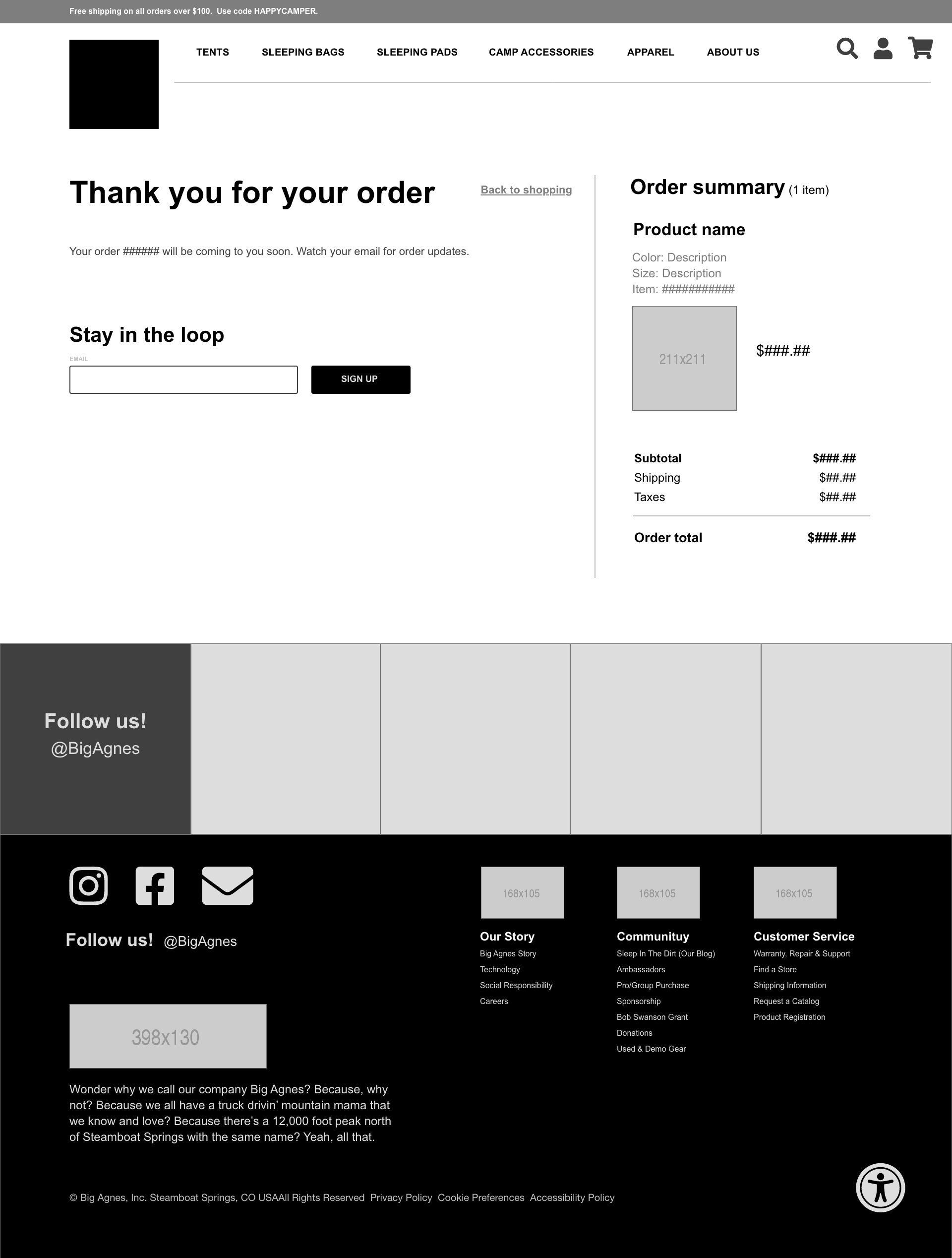
Throughout the checkout process, the user’s order information stays anchored on the right. They are able to add a promotional code throughout the process. The checkout process starts with a login or email entry. Social media integration was added to allow users to log in via Google. Additionally, users have the option to check out as a guest, but an email is still required. An explanation is included under the email form to give users peace of mind.
One of the challenges in simplifying the checkout process was in removing unnecessary page elements while keeping functionality essential for the user. This was resolved by including links to navigate back to other areas of the site while in the checkout process. Users can navigate back to the site by clicking on the “Back to shopping” link at the top of the page, or by clicking on the Big Agnes logo on the top left corner. Users are also able to go back and edit sections they have completed by clicking on the “Edit” link once a section is completed.
The purchase confirmation page includes the order number, instructions for next steps and one last opportunity to sign up for the email newsletter. Users can navigate back to the homepage by clicking on “Back to shopping,” the Big Agnes logo or by using the main navigation.
Redesign Conclusion
The wireframes propose changes to the Big Agnes site to simplify the user experience, reduce friction, and provide helpful content and processes to ensure a smooth experience. By reducing jargon and bringing in informative articles, the site SEO will also be improved to increase organic traffic. Improving the customer experience is central to these changes.
Sources
15 Best USA Cities For Hiking & Outdoor Adventure. Retrieved 20 March 2021, from https://www.tripadvisor.com/VacationRentalsBlog/2018/08/15/best-us-cities-for-hiking/.
Big Agnes | Mother of Comfort - Sleeping Bags, Pads & Tents. (2021). Retrieved 11 March 2021, from https://www.bigagnes.com/.
Big Agnes [@bigagnes_]. (2021, March 16). NEW Tiger Wall UL Solution Dye Tent [Instagram video]. Retrieved 16 March 2021, from https://www.instagram.com/tv/CMe_ndfpB-k/.
Crowe, A. 15 Important Conversion Metrics & Business KPIs You Should Track. Search Engine Journal. (2019, January 18). Retrieved 24 March 2021, from https://www.searchenginejournal.com/content-marketing-kpis/business-conversion/.
Google AdWords. (2021). Retrieved 3 April 2021, from https://ads.google.com/aw/keywordplanner/home.
Hoos, D. (2018). Effective Ecommerce A/B Testing in 2018 [Step-By-Step Guide]. Retrieved 28 March 2021, from https://www.bigcommerce.com/blog/ab-testing/.
Moreno, A. (2013). Data-Driven Design In The Real World — Smashing Magazine. Retrieved 26 March 2021, from https://www.smashingmagazine.com/2013/09/data-driven-design-in-the-real-world/.
OIA - Together We Are A Force. (2021). Retrieved 18 March 2021, from https://outdoorindustry.org/. Outdoor Foundation. (2020). “2020 Outdoor Participation Report.” Retrieved 16 March 2021 from https://outdoorindustry.org/participation/.
Outdoor Foundation. (2020). “2020 Outdoor Participation Report.” Retrieved 16 March 2021 from https://outdoorindustry.org/participation/.
SimilarWeb. (2021). Bigagnes.com Traffic, Ranking & Marketing Analytics. Retrieved 20 March 2021, from https://www.similarweb.com/website/bigagnes.com/#overview.
Sleeping Bags : Target. (2021). Retrieved 16 March 2021, from https://www.target.com/c/sleeping-bags-camping-outdoor-recreation-sports-outdoors/-/N-5xt5w?Na o=0. TripAdvisor. (2018).
Ubersuggest. (2021). Retrieved 3 April 2021, from https://app.neilpatel.com/en/ubersuggest/keyword_ideas?keyword=big%20agnes%20sleeping%20b ag&locId=2840&lang=en.
Contact
LinkedIn: hannanorris
Instagram: @hn.de_sign
Behance: @hnorris
© Hanna Norris 2023